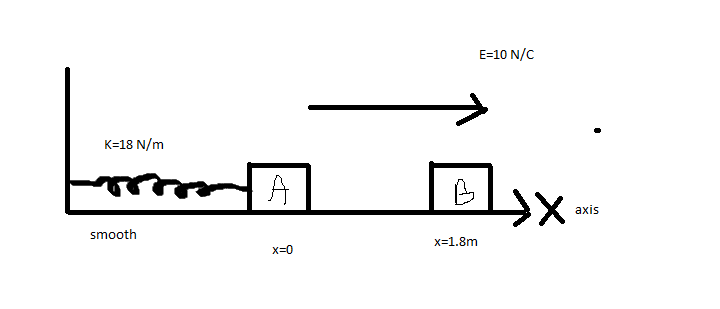Amplitude of Oscillation!

In the figure . Block is neutral while . sizes of and are negligible. is released from rest at a distance from . Initially springs is neither compressed nor elongated. The amplitude of oscillation of the combined mass will be?
No vote yet
8 votes
Easy Math Editor
This discussion board is a place to discuss our Daily Challenges and the math and science related to those challenges. Explanations are more than just a solution — they should explain the steps and thinking strategies that you used to obtain the solution. Comments should further the discussion of math and science.
When posting on Brilliant:
*italics*or_italics_**bold**or__bold__paragraph 1
paragraph 2
[example link](https://brilliant.org)> This is a quote# I indented these lines # 4 spaces, and now they show # up as a code block. print "hello world"\(...\)or\[...\]to ensure proper formatting.2 \times 32^{34}a_{i-1}\frac{2}{3}\sqrt{2}\sum_{i=1}^3\sin \theta\boxed{123}Comments
Block B experiences a force of F=qBE=−10 N over a distance of Δx=−1.8 m.
So, it's velocity just before it hits Block A is vB=−mB2FΔx=−6 m/s.
Once Block A and Block B collide, their combined mass is mA+mB.
By conservation of momentum, the velocity of the combined mass just after collision is: v0=mA+mBmBvB=−3 m/s.
The total force acting on Block A and Block B is −kx+qBE (spring force plus electric field force).
Using Newton's 2nd Law, the position of the combined mass as a function of time is given by the differential equation
(mA+mB)x′′=−kx+qBE, i.e. (2 kg)x′′+(18 N/m)x+10 N=0,
with initial conditions x(0)=0 m and x′(0)=−3 m/s.
The solution is x(t)=(0.556 m)cos((3 rad/s)t)−(1 m)sin((3 rad/s)t)−(0.556 m).
The amplitude of oscillation is simply (0.556 m)2+(−1 m)2=1.144 m.
Let me know if there are any mistakes.
Log in to reply
thanks! I did it using W.E. Theorem.
You have probably done no mistake. Here is an easier one: Equillibrium position is x=9−5,vx=0=3m/s Applying conservation of energy from x=0tox=9−5, 21(mA+mB)((vmax)2−(vx=0)2)+21kx2=Ex Solving, we get vmax=3106 , Now, A=wvmax=33106[as w = angular frequency =3secrad] = 1.144m
Log in to reply
Can you please tell how to write in different paragraph, even the lines in different paras appear together.
You have not mentioned anything about the nature of collision i.e. the value of coefficient of restitution for the collision to take place. Anyway, assuming it is a perfectly elastic collision, find the energy of the system just before collision and at either of compressed or elongated states. From there get the compression or elongation and your amplitude is double that value. ( The value of k is not visible enough, looks to be 16N/m , amplitude comes out to be 3m)
Log in to reply
The collision is perfectly inelastic, and K=18N/m
What is projectiles? A projectile is fired at an angle of 60 degre,to the horizontal and with the initial velocity of 80m/s.calculate A) time of flight B) the time taken to get to the maximum hight C) the rane D) the maximum range E) the velocity projection 2seconds after being fired(g=10m/s
Log in to reply
http://en.wikipedia.org/wiki/Projectile_motion